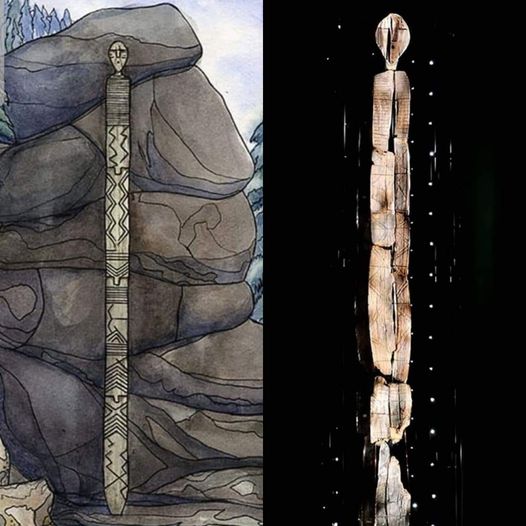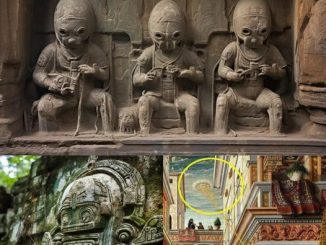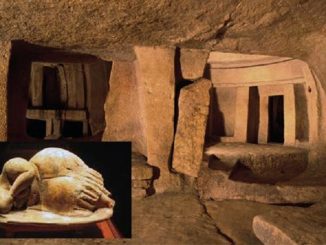The Shigir Idol, discovered in Russia in 1890, stands as one of the most enigmatic and ancient wooden sculptures known to humanity. Dated to approximately 12,000 years ago, this extraordinary artifact was preserved in a peat bog, which safeguarded its intricate carvings from the ravages of time. The Idol’s sheer age and the mystery surrounding its purpose have made it a subject of fascination and study for archaeologists, historians, and art enthusiasts alike. In this blog post, we delve into the discovery, significance, and potential interpretations of the Shigir Idol, inviting readers to explore its captivating story and view the remarkable images that capture its ancient splendor.

Discovery and Preservation
The Shigir Idol was unearthed in 1890 by gold prospectors in a peat bog near Kirovgrad, in the Ural Mountains of Russia. This peat bog, known for its exceptional preservative qualities, protected the wooden sculpture for millennia, keeping it in remarkable condition. The Idol was initially found in fragments, which were painstakingly pieced together by archaeologists to reveal its original form.
Standing at 2.8 meters tall today, the Shigir Idol is believed to have originally been over 5 meters in height. Carved from a single larch tree that was approximately 159 years old at the time, the sculpture’s longevity can be attributed to the anaerobic conditions of the peat bog, which inhibited the decay that typically afflicts organic materials. The Idol’s preservation is a testament to the environmental factors that allowed such a fragile artifact to survive for over twelve millennia.
The Artistry and Symbolism of the Shigir Idol
The Shigir Idol’s carvings are both intricate and profound, offering a glimpse into the artistic and cultural practices of its creators. The sculpture features a series of faces, hands, and geometric patterns, including zigzag lines, that are meticulously etched into its surface. These designs were crafted using stone tools and the jaw of a beaver, highlighting the resourcefulness and skill of the prehistoric artists.
The purpose of the Shigir Idol remains a subject of speculation and debate among scholars. Some suggest that it served as a territorial or navigational marker, guiding ancient peoples through the dense forests and shifting landscapes of postglacial Eurasia. Others propose that the Idol had a ritualistic or spiritual significance, possibly depicting forest spirits or embodying a creation myth. The faces and patterns might represent ancestral figures or deities, providing a means for early humans to connect with the divine or to assert their presence in a changing world.
Thomas Terberger, a scholar of prehistory at Göttingen University in Germany, posits that the Idol was carved during a period of significant climate change, when early forests were spreading across a warming landscape. This era of transition likely influenced the art and symbolism of the time, as people adapted to new environments and sought ways to understand and navigate the challenges they faced. The Shigir Idol, with its figurative and abstract designs, may have been a tool for coping with these changes, offering both practical guidance and spiritual solace.
The Shigir Idol in Context: A Comparative Analysis
To fully appreciate the Shigir Idol’s significance, it is essential to place it in the broader context of prehistoric art and human history. This sculpture predates the founding of major cities and civilizations, such as London and Stonehenge, by thousands of years. Its age, estimated to be around ten thousand years before the establishment of London and over twice the age of Stonehenge, underscores the depth of human creativity and expression in the prehistoric era.
Comparative analysis with other ancient artifacts reveals the unique characteristics of the Shigir Idol. While many prehistoric artworks are found in caves or rock shelters, the Idol stands out as a freestanding wooden sculpture, a rarity due to the perishable nature of wood. This distinction highlights the innovation and adaptability of its creators, who utilized available materials to craft a lasting legacy.
The Idol also provides a valuable contrast to other known prehistoric artworks, such as the cave paintings of Lascaux and Altamira, which primarily depict animals and hunting scenes. The Shigir Idol’s abstract and anthropomorphic designs suggest a different cultural and symbolic framework, one that perhaps emphasized spiritual or territorial themes over purely subsistence-related imagery. This diversity in prehistoric art enriches our understanding of early human societies and their varied responses to their environments and existential questions.
Modern Discoveries and Continuing Research
The Shigir Idol continues to captivate researchers and the public alike, prompting ongoing studies and new discoveries. Advances in technology and methodology have allowed for more precise dating and analysis of the Idol, revealing insights into its construction and significance. Radiocarbon dating has confirmed its incredible age, making it one of the oldest known wooden sculptures in the world.
Modern investigations have also explored the Idol’s context within the peat bog, examining the environmental conditions that contributed to its preservation. These studies suggest that the Idol may have been deliberately placed upright next to an ancient lake before it fell into the bog, a hypothesis that adds a layer of intentionality and ritual to its history. Understanding the Idol’s original setting can provide clues about its purpose and the cultural practices of its creators.
The Shigir Idol’s presence in the Sverdlovsk Regional Museum of Local Lore in Russia allows visitors to experience its majesty firsthand. The museum’s display, accompanied by detailed information and imagery, offers a window into the distant past and the enduring legacy of this remarkable artifact. Viewing the images of the Idol, with its intricate carvings and imposing stature, evokes a sense of wonder and curiosity, inviting us to reflect on the ingenuity and spirituality of our ancient ancestors.
Conclusion
The Shigir Idol stands as a monumental testament to the artistic and cultural achievements of prehistoric humans. Its discovery, preservation, and continuing study illuminate the complexities of early human societies and their interactions with their environments. The Idol’s intricate carvings, mysterious symbolism, and remarkable age make it a subject of enduring fascination and significance.
As we explore the Shigir Idol and other ancient discoveries, we gain a deeper appreciation for the ingenuity and resilience of our ancestors. These artifacts connect us to a distant past, revealing the continuity of human creativity and the timeless quest for meaning and understanding. The Shigir Idol, with its enigmatic beauty and profound history, invites us to look closer, think deeper, and marvel at the richness of our shared heritage.
For those intrigued by the Shigir Idol’s story, we encourage you to view the images and artifacts that capture its ancient splendor. These visual representations offer a tangible connection to the past, allowing us to witness the artistry and craftsmanship of prehistoric humans and to appreciate the enduring legacy of their creations.
4o


